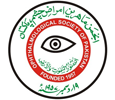ISSN 0886-3067



Volume No 35 Issue No 2
Role of Topical Cyclosporine in Prevention of Pterygium Recurrence, after Primary Excision
Purpose: To study the effect of cyclosporine on pterygium recurrence after primary excision Study Design: Non randomized controlled trial. Place and Duration of Study: The study was conducted in the department of Ophthalmology, Liaquat University of Medical and Health Sciences, Jamshoro from 2015 to 2017. Material and Methods: One hundred and thirty eyes of 65 patients having bilateral pterygium, at least 2 mm encroaching on the cornea, were selected for study. Dimensions of pterygium were measured on slit lamp. Half of the eyes were selected for post-operative cyclosporine and was named as cyclo- eye and fellow other eye was named as non-cyclo eye. Immediate post-operative treatment was tobramycin dexamethasone eye ointment twice and moxifloxacin eye drops three times daily until corneal epithelium was restored, followed by moxifloxacin and Cyclosporine eye drops twice daily until complete healing of ocular surface occurred and then cyclosporine 0.05% alone once daily in the evening up to three months. In the fellow eye tobramycin dexamethasone eye ointment and moxifloxacin eye drops were used for complete healing time followed by tears alone three times for three months. Follow up was done for six months. Results: Only Fifty-three patients who completed 6 months of follow-up were included in the results. In cyclo-eyes recurrent pterygium was observed only in 4 (07.55%) and in non-cyclo eyes recurrence was observed in 23 (43.40%) eyes. Mean healing time in cyclo-eyes was 21.1354 days and in non-cyclo-eyes, 15.0213 days. Conclusion: Cyclosporine is effective in reducing the recurrence rate of pterygium. Key Words: Pterygium, Cyclosporine, Cornea.
HTML Full Text | Complete PDF